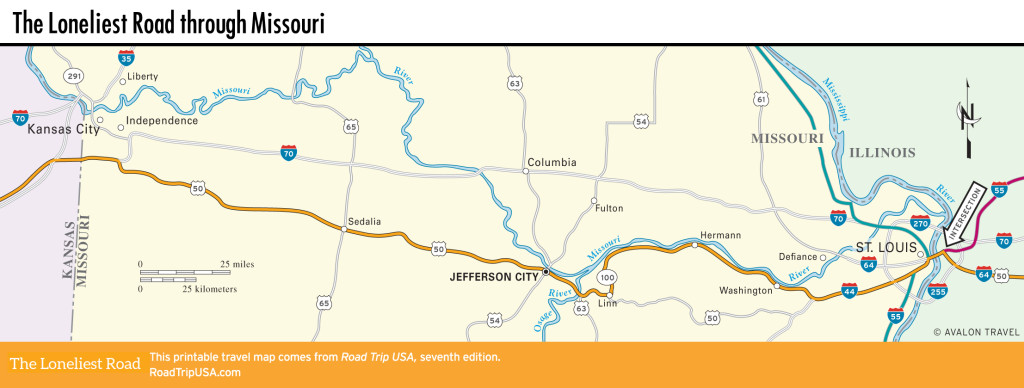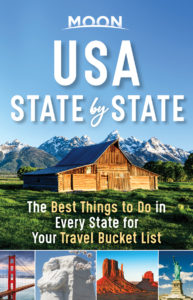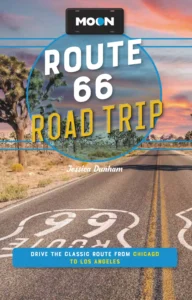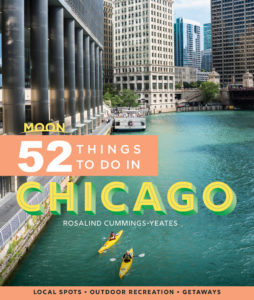Kansas City
US‑50: Across Kansas City
US-50 is now submerged beneath the interstates and runs west-east around Kansas City via I-35, I-435, and I-470. The older pre-interstate route also avoided downtown, following what’s now signed as US-169 along Park Avenue and 47th Street, past the Country Club Plaza and the Nelson-Atkins Museum of Art, before dipping south again on the Swope Parkway to Lee’s Summit, where the old alignment rejoins the current US-50 routing.
To reach the downtown area from US-50, you can follow any of many north-south streets, like Troost Avenue, the down-at-the-heels old main drag, or the parkway-like The Paseo.
Exploring Kansas City
Though it covers a huge area, stretching for some 20 mi (32 km) on both sides of the Missouri-Kansas border, and nearly 30 mi (48 km) north to south, Kansas City (pop. 491,918) never feels like a big city. It’s more like a conglomeration of small towns, once separate from each other but now joined together by tract-house sprawl and the 83-mi-long (134-km) I-435 Beltway. The historic center of Kansas City lines the south bank of the Missouri River, where 30-story skyscrapers stand above hefty brick warehouses, huge stockyards, railroad tracks, and banks of grain elevators, all testifying to Kansas City’s role as the main distribution point for Midwestern farm products.
Southwest of the city center, off Main and 40th Streets, Westport is the birthplace of Kansas City. Before the Kansas River switched course and left it high and dry, Westport was the westernmost steamboat landing in the United States, and it quickly grew into a prime supply point on the Santa Fe and Oregon Trails. For a better taste of old-time riverfront Kansas City, head downtown to the Steamboat Arabia Museum (400 Grand Blvd., 816/471-1856, daily, $14.50), in the historic City Market, which displays the fascinating contents of a steamboat that sank in 1856: hardware, guns, clothes, booze, canned and bottled food, and all sorts of things that made life on the western frontier livable.
Located on the south side of Westport, the remarkable Nelson-Atkins Museum of Art (4525 Oak St., 816/561-4000 or 816/751-1278, Wed.-Sun., free) would do any city proud, with a little of everything from Caravaggio’s brooding masterpiece St. John the Baptist to in-depth coverage of KC-based Thomas Hart Benton. The nation’s coolest parking structure sits underneath the museum’s translucent Bloch Building. Two blocks west is another architectural innovation: Country Club Plaza, one of the country’s first shopping malls, with opulent Spanish Revival styling and upscale retailers.
At the south edge of downtown, the historic tower of the Liberty Memorial has been joined by the thought-provoking National World War I Museum and Memorial (816/888-8100, daily summer, Tues.-Sat. fall-spring, $18), which pays tribute to the soldiers while putting the conflict into its complicated political context.
A mile (1.6 km) east of downtown KC is the revitalizing 18th and Vine neighborhood, heartland of Kansas City’s prolific 1930s and 1940s African American music scene, a golden age that spawned jazz greats Charlie Parker, Lester Young, and Count Basie, all of whom are honored in the American Jazz Museum (1616 E. 18th St.), which shares space with the marvelous Negro Baseball Leagues Museum (1616 E. 18th St., 816/221-1920, Tues.-Sun., $10 each or $15 for both), dedicated to documenting the players and culture of the various professional baseball leagues that existed side-by-side with the “majors” before the color barriers began to be broken down in the late 1940s.
Where to Stay and Eat in Kansas City
To get around Kansas City, drive. As in Los Angeles, which Kansas City resembles more than residents of either city are likely to admit, cars rule the roads. Distances are huge and public transportation is basically nonexistent.
In downtown Kansas City, there are a number of nicely restored grand 1920s hotels: the Hilton President (1329 Baltimore Ave., 816/221-9490, $232 and up) is a block away from the Holiday Inn Aladdin (1215 Wyandotte St., 816/421-8888, $162 and up). Budget-conscious travelers can choose from a slew of highway motels lining the interstates.
For food, there’s no better introduction to the delights of KC cuisine than Arthur Bryant’s (1727 Brooklyn Ave., 816/231-1123), east of downtown near the Negro Baseball Leagues Museum. Meat-eaters drive for miles to eat at this classic no-frills rib shack, where heavenly barbecue sauces come in plain plastic bottles. More world-class barbecue is on the menu (along with delicious steaks, seafood, and salads) in the fancy environs of Fiorella’s Jack Stack Barbecue (101 W. 22nd St., 816/472-7427) in KC’s lively and history-rich Crossroads Arts district, as well as four other locations around town. For burgers, fries, malts, and shakes (and a killer cherry limeade!), look no farther than Winstead’s (101 Emanuel Cleaver II Blvd., 816/753-2244), across from the art museum, near Country Club Plaza.
Kansas City’s once-vaunted nightlife is nothing like it was during the jazz and R&B heyday of the 1940s and 1950s, though there’s always something going on in the ambitious “P&L,” the Power and Light District, where bars, clubs, restaurants, and street performers cover eight downtown blocks around 13th and Main Street. One other place to go: The historic Kelly’s Westport Inn (500 Westport Rd., 816/561-5800) is a great place to enjoy a budget-priced beer while soaking up some old KC ambience.

















